This was published 3 years ago
Europe train travel guide: Fast or slow, here's how to see Europe by train
By Tom Hall, Imogen Hall and Oliver Smith
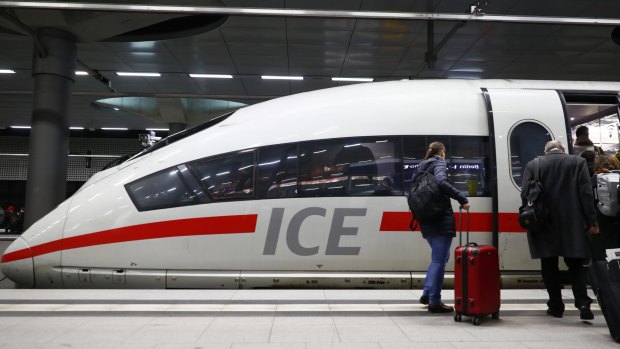
German high-speed trains operated by Deutsche Bahn under their international ICE category trains run into Denmark, France, Belgium, the Netherlands, Austria, Switzerland and Italy.Credit: Getty Images
There is no better way to arrive in a city than by train. Catch a plane and you must negotiate luggage carousels, passport checks, shuttle buses, a maze of duty free shops. Drive a car and your first impression of a city will be suburbs, industrial estates, and tortuous, creeping traffic.
But arrive by rail and, more often than not, you will be magically ushered right to the centre of a city, slicing through urban sprawl to a station that lies at its beating heart.
The greatest station architects knew this truth. They built grand terminuses which are less like transport hubs, and more like temples to the cities they serve, adorned with statues and with vaults like cathedrals.
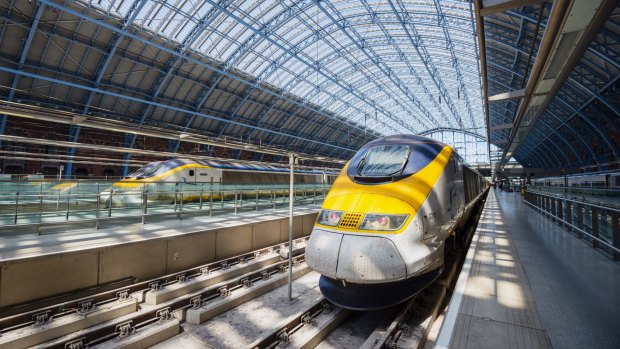
Eurostar connects London's St Pancras International with Lille, Brussels, Paris and Amsterdam. Credit: Justin Foulkes
In the following guide we'll explain the dramatic and exciting changes that a more sustainability-minded European rail passenger system is undergoing and also how you can benefit, as a savvy and thoughtful traveller.
ON TRACK TO A FASTER, GREENER FUTURE
European trains are synonymous with this gilded past. But so too are they creating the future. Year by year, a web of high-speed services has crept further across Western Europe with the expansion coinciding with France, in a landmark move, legislating a ban on short-haul domestic flights on routes where train journeys of two and a half hours or less exist as an alternative.
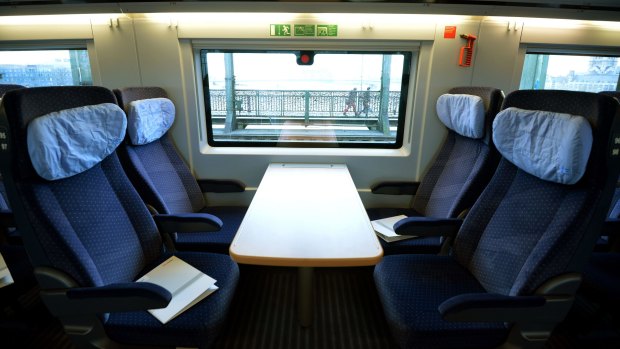
The second class compartment on board an ICE Deutsche Bahn high-speed train.Credit: Getty Images
When the law goes into effect this month, a remarkable 12 per cent of French domestic flights will be wiped from schedules. It's why there's no better time than right now, with the northern summer holiday season approaching, for travellers to understand the new and greener realities of getting around Europe.
The fastest trains on the continent are capable of going half the cruising speed of a jet aircraft. And, unlike aircraft, these futuristic trains come to a slow, graceful halt in the city centres.
For the price of a few more hours travelling, high-speed rail offers pleasures more sublime than any short-haul aircraft can provide.
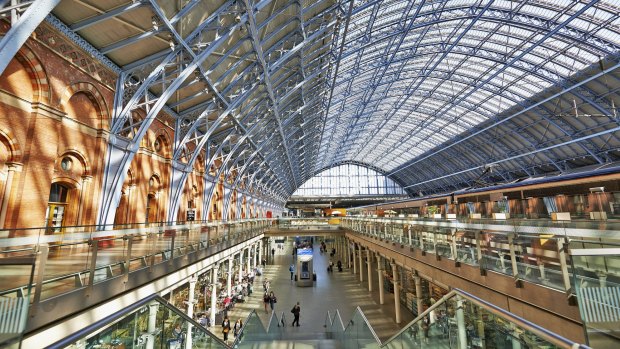
St Pancras Station is the main rail terminal for the Eurostar.Credit: iStock
These advantages have not escaped the attention of the European Union. Its bold objective is to double high-speed rail traffic by 2030, according to The Economist, with trains that can out-compete flights on routes of up to 800 kilometres, provided they're capable of travelling at 200 kilometres per hour or more.
Flights are believed to contribute to 2 per cent of global carbon emissions and are markedly worse for the environment than equivalent train services. There's no easy way to calculate how much worse – it depends on the distance travelled and the kind of plane or train you travel in.
Nonetheless, Eurostar, which operates services from London to the continent, estimates that catching a train rather than a plane from London to Paris could see your personal emissions cut by as much as 90 per cent.
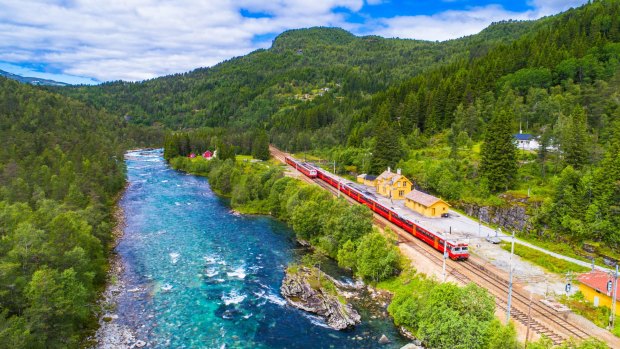
Oslo-Bergen in Norway is one of Europe's most scenic train trips.Credit: Marius Dobilas
LET'S SLEEP ON IT
One of the best ways to cover a lot of ground by train, save yourself the cost of a night's accommodation and experience a truly unique arrival in a destination is to take a sleeper.
Falling asleep to the rhythmic clunking of the wheels is special in itself, but nothing beats opening your eyes to realise you are trundling across a completely different landscape as the sun rises.
Accommodation options range from upright airline-style seats and basic couchettes (shared compartments), to the preferable superior, private sleepers where beds are made up for you and you have more space, often a sink and occasionally a toilet and shower.
Beds are normally single bunks but the recent upgrade on the UK's Caledonian Sleeper (sleeper.scot) introduced some en-suite rooms with double beds; it's worth checking the options on your route as things are developing in this area.
Note, too, that you cannot travel on a night train without a reservation. You can make these bookings online or in person at the station. As there are a limited number of berths on these trains, if you want to reserve a whole compartment you should book as early as you can.
Using the operator's own website will usually give you the best overview in terms of the different options and availability – and means you can sign up to alerts if there are special offers available.
Although the pandemic led to a swift downturn in global travel, it has also given travellers and governments a chance to reassess their transport priorities with resurgent sleeper, or overnight, trains at the forefront of their thinking.
As high-speed lines continue to develop across the continent, so are sleeper-train services, which seem to be having a renaissance after being on the brink of extinction a decade ago.
Austrian operator Nightjet (nightjet.com) has added to its routes in recent times, while a number of private operators, such as French outfit Midnight Trains (midnight-trains.com) promise to revolutionise the overnight experience for climate-conscious travellers.
Then, before you know it, you are tipped out into the true centre of a city which is still waking up, allowing you to adjust gently to a new place.
Searching quiet, early morning streets for that essential coffee allows you to get your bearings, take a deep breath and enjoy a sense of calm before the rest of the day's exploration unfolds. And unless you sleep like the proverbial log, you will find that that coffee is essential.
European night trains are very comfortable, especially if you are in a couchette or sleeper compartment with a proper bed rather than an upright seat. But the trains do stop and start, roll forward and halt suddenly, guards shout, horns get tooted, luggage gets moved around, people get on and off – and if you're crossing an international border you may have to show your documentation in the middle of the night.
TAKE ME TO THE BORDERS
There's certainly no shortage of ways to cross Europe's borders on steel wheels, to move between the patchwork of nations that makes up the continent, from multi-day sleeper trains to glamorous high-speed expresses to regional curiosities.
Several rail companies operate international routes across various European regions. These services often connect with other key international and domestic services at key hub stations, and generally must be booked in advance.
Services are well-used by leisure and business travellers so expect trains to be busy during peak hours and at popular holiday times.
Thalys (thalys.com) is a high-speed service owned by SNCF and SNCB (respectively the French and Belgian state railways). It serves France, Belgium, the Netherlands and Germany, connecting Paris, Brussels, Amsterdam, Cologne, Dortmund and points in between.
It only stops at major cities, guaranteeing fast journey times, and connects conveniently (if tightly) with Eurostar (eurostar.com) services, meaning it's heavily used by business travellers and tourists.
Thalys also offers a low-cost brand only operating between Paris and Brussels, IZY. Summer services extend to Avignon and Marseille. The Thalys Neige ski train reaches French Alpine winter sports destinations including Chambéry and Bourg-Saint-Maurice.
There are three classes on Thalys trains: standard; comfort; premium. All come with free Wi-Fi. Light meals are served at-seat in Premier class and are included in the ticket price. Reservations are required for all services.
Eurostar connects London's St Pancras International with Lille, Brussels, Paris and Amsterdam. These distinctive blue and yellow trains use the HS1 high-speed line between London and the Channel Tunnel on the UK side.
Once in continental Europe they makes use of the LGV Nord high-speed line (which also carries Thalys services) between Paris, Calais, Lille and Brussels.
A winter ski train follows the Thalys Neige path into the Alps, while summer services have in the past offered a direct connection to destinations in the south of France including Lyon, Avignon and Marseilles.
Eurostar offers standard, standard premier and business premier seating (eurostar.com). Bookings generally open 180 days in advance of the date of travel – sooner than potential onward services, so consider waiting if you're looking to connect onwards via Paris or Brussels.
The flagship sleeper train brand of ÖBB (oebb.at), or (Austrian Railways, Nightjet comprises the bulk of Europe's night-train services. Radiating in all directions from Vienna and Salzburg, routes reach Belgium, Germany, Switzerland, Italy and the Netherlands.
Sleeper services run by operators in neighbouring countries reach Croatia, Hungary, Slovakia, Czech Republic, Poland and Ukraine from Austria.
As they're not run by Nightjet expect different, mostly older sleeping cars. There are three classes of Nightjet services: a seat in a compartment; a 4-6 berth couchette; and economy or deluxe sleeper accommodation in single, double- or triple-occupancy cabins.
Deluxe berths come with a toilet and shower. Note that solo travellers will, in all cases apart from designated single cabins, share with other travellers of the same gender. Booking in advance is highly recommended, and compulsory in Germany and Italy.
A high-speed premium service owned by ÖBB and Czech Railways (cd.cz), Railjet connects Austria and the Czech Republic with other European countries. Key destinations include Prague, Munich, Budapest and Vienna.
German high-speed trains operated by Deutsche Bahn under their international ICE category run into Denmark, France, Belgium, the Netherlands, Austria, Switzerland and Italy (bahn.com).
TGV (sncf-connect.com) and high-speed joint operations like TGV Lyria (serving Swiss destinations to/ from France) commence or terminate in France, connecting major cities with neighbouring countries.
TICKETS TO RIDE
There's no escaping it: planning your first epic rail journey across Europe can be daunting. Unlike airlines, where you'll pay one company to transport you from point to point, travelling by rail around the continent will mean dealing with multiple national networks – and quite possibly with more than one company within those networks.
There are no hard and fast rules for getting the best ticket: it often depends on personal preference. Even so, there are a few pointers to put you on the right track.
Before you jump online and start booking, remember regional trains and even some express services don't need to be purchased in advance – you can show up at the station on the day and pay the same price.
If it's possible – for instance at the tail end of a long-distance journey, or on a day where you have no onward connections – you might prefer to buy tickets for these slower trains in person, so allowing a degree of flexibility.
Try this last-minute tactic with flagship high-speed services like AVE (renfe.com), ICE and TGV, however, and you may end up paying top dollar. As with flights, it can often help to book tickets for fast and long-distance trains well in advance.
Tickets take myriad forms, but generally advance, non-flexible tickets for specific departures booked well before the date of travel can be far cheaper than flexible tickets bought just hours before jumping on board.
The former are a good choice if you want to save money and are confident your itinerary is set in stone; the latter allow for some spontaneity. Be aware that booking trains in different countries works in different ways – even for high-speed trains.
For instance, TGV trains (where seat reservations are mandatory) sell out like seats in a theatre, whereas ICE trains in Germany (where seat reservations are not mandatory) generally do not sell out – you can buy a ticket for a busy train right before departure and squeeze on board.
Your first port of call for domestic journeys within one country will likely be the national operator. Some of these websites are better than others, and you may want to book through a third party for ease of use. For most international journeys it's worth checking tickets with operators at your point of departure and arrival, such as SNCF and Deutsche Bahn if you're going from France to Germany. In short: shop around.
Third-party websites – notably thetrainline.com and raileurope.com – are easy to use and provide an excellent overview of train services across the continent. More so than most national operators, they can be extremely useful tools for planning too, and their paper or digital-tickets can be preferable to collecting them at the station.
European rail passes are world renowned, the most famous being Interrail (for those who live in Europe), and Eurail (eurail.com) for those visiting from outside. Both allow unlimited travel across 33 European countries over a certain period (from four days to three months) for a set fee.
Be aware you often need to pay a supplement on high-speed services and sleepers. Whether a pass is worth it depends on where you plan to go and which trains you plan to ride. There's one distinct advantage though: these passes offer the flexibility to go when and where you want, without expensive on-the-day fares.
This story is based on Lonely Planet's Guide to Train Travel in Europe, authored by Tom Hall, Imogen Hall and Oliver Smith, $39.99 RRP. Available at selected book stores or via shop.lonelyplanet.com
FIVE OF EUROPE'S MOST SCENIC RAIL JOURNEYS
LOCARNO, SWITZERLAND TO DOMODOSSOLA, ITALY
Travelling between Locarno in Switzerland and Domodossola in Italy, the Centovalli (Hundred Valleys) Railway is a short but scenic service travelling past 52 kilometres of waterfalls, chestnut groves, church-topped villages, deep ravines, and vineyards.
OSLO TO BERGEN, NORWAY
The Begensbanen, a contender for Europe's best train trip, thunders past southern Norway's mountains and lakes between Oslo and Bergen, reaching 1222 metres at Finse station, where a snowball fight is generally on offer.
PARIS TO LATOUR DE CAROL, FRANCE
Heading first to the elegant city of Toulouse and then south past dramatic castles and hilltop scenery, this route terminates in the Pyrenees with onward connections to Barcelona. This journey can be done as a sleeper or as a series of day trains.
THE BLACK FOREST RAILWAY, GERMANY
This line slices through this sublime, natural gem in southern Germany. At Baden-Baden you can join trains travelling south on the line, alighting enroute in the half-timbered town of Gengenbach (30 minutes from Baden-Baden), where taverns cluster under pointed towers at the threshold of the woods.
NORTH WALES, LLANDUDNO TO PORTHMADOG LOOP
Combine two of the world's most beautiful narrow-gauge railways to take in Snowdonia's mountains and coastal scenery. Catch a service from Llandudno Junction to Blaenau Ffestiniog and change for the Ffestiniog Railway. Return via the Welsh Highland Railway to Caernarfon, where you can catch a bus back to Bangor and the main line.
FIVE OF EUROPE'S ICONIC SLEEPER TRAINS
LONDON TO SCOTLAND
The recently upgraded Caledonian Sleeper transports you between London and southern Scotland (on the Lowlander) and northern Scotland (on the Highlander) in around eight hours
MILAN TO SICILY
Not only does this route take you down the full length of Italy, it crosses the Strait of Messina to Sicily on a ferry that takes your train on board.
ZURICH TO HAMBURG
The entire Nightjet network is a joy, but for something a little different, this route offers the chance to sleep on a double-decker night train.
STOCKHOLM TO NARVIK
When the Arctic Circle calls, book a berth on this 20-hour sleeper. And as Sweden is the home of flygskam (flight shame), you'll be travelling on a train with impeccable green credentials.
BUDAPEST TO SPLIT
This summer-only option whisks you from the beautiful Budapest Keleti station to the Croatian coast as you sleep, meaning you can be swimming in the Adriatic Sea by lunchtime.
Sign up for the Traveller Deals newsletter
Get exclusive travel deals delivered straight to your inbox. Sign up now.